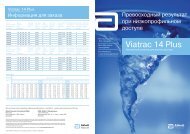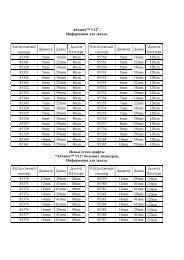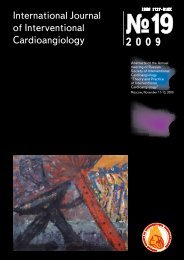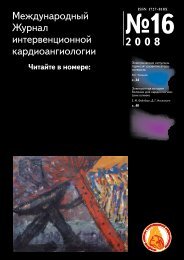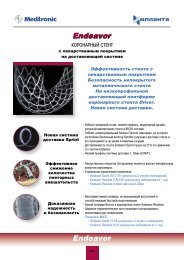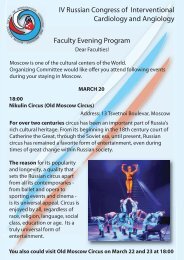International Journal of Interventional Cardioangiology
International Journal of Interventional Cardioangiology
International Journal of Interventional Cardioangiology
You also want an ePaper? Increase the reach of your titles
YUMPU automatically turns print PDFs into web optimized ePapers that Google loves.
INTERVENTIONAL CARDIOLOGY<br />
tion <strong>of</strong> thrombolytic therapy –ST elevation rises up<br />
to 160% from baseline within 9 minutes. Further<br />
ST-segment starts to decrease reaching the prepeak<br />
values within 9 minutes, and in 95 minutes ST<br />
segment decreased staying at the same level within<br />
the next day. Development <strong>of</strong> the sharp peak <strong>of</strong><br />
increase in ST-segment elevation in 15 minutes after<br />
thrombolytic administration was accompanied by the<br />
episodes <strong>of</strong> idioventricular rhythm with heart rate 58<br />
to 78 beats per minute lasting up to 1 minute, which<br />
were considered to be the reperfusion arrhythmias.<br />
The example <strong>of</strong> similar changes in ST-segment in<br />
inferior AMI is shown on figures 2, 3. A 59 years old<br />
patient diagnosed with the peracute phase <strong>of</strong> inferior<br />
AMI was hospitalized within 5 hours 20 minutes from<br />
the onset <strong>of</strong> first in life angina attack. Maximal degree<br />
<strong>of</strong> ST elevation was 180 uV and was observed in lead<br />
III. Thrombolytic therapy was started. In 20 minutes<br />
dramatic peak <strong>of</strong> increase in ST elevation to 280 uV was<br />
recorded, which corresponds to 155% <strong>of</strong> the baseline<br />
value. ST elevation raised to maximal values within 3<br />
minutes, and then ST-segment decreased rapidly to<br />
baseline level within 7 minutes; and within 36 minutes<br />
ST was stabilized at 50 uV level remaining the same<br />
within the next day. STIII level was 50 uV on the control<br />
ECG recorded in 90 minutes after the drug administration,<br />
ST-segment decreased by 72% from baseline suggesting<br />
the effective thrombolytic therapy. Reperfusion<br />
arrhythmias were recorded in time period near the ST<br />
peak, in this patient the arrhythmias were manifested<br />
as episodes <strong>of</strong> severe sinus bradycardia up to 41 beats<br />
per minutes, frequent ventricular extrasystoles, and<br />
episodes <strong>of</strong> unstable ventricular tachycardia.<br />
It is worth noting that there were no recurrent<br />
angina attacks at the moment <strong>of</strong> sharp-pointed ST<br />
peak recording in any patient.<br />
Dramatic intermittent character <strong>of</strong> increase in<br />
ST elevation suggested an immediate relationship<br />
between the peak and reperfusion moment. The<br />
data from the experimental studies provided basis<br />
<strong>of</strong> this hypothesis. Thus, studies using intramyocardial<br />
electrodes described rapid hyperpolarization <strong>of</strong><br />
cells during reperfusion, greater decrease in action<br />
potential duration compared to ischemia period<br />
that was accompanied by superficial ECG changes<br />
expressed as a positive shift <strong>of</strong> TQ, ST and T-wave<br />
peak (9).<br />
If the observed sharp-pointed peak is caused by<br />
blood flow restoration in the infarct-related artery,<br />
then rapid decrease in ST level was to be expected.<br />
Indeed, when sharp reperfusion ST peak was recorded<br />
during thrombolytic therapy, ST level was normalized<br />
more rapidly in 79% <strong>of</strong> patients as compared to<br />
the group without specific peak (table 1).<br />
In the group with peak, the ST-segment decreased<br />
fully and stabilized at the level close to the isoelectric<br />
line – within 100±51 minutes from the initiation <strong>of</strong><br />
thrombolysis. On the contrary, in the group without<br />
“reperfusion” peak, the time <strong>of</strong> the ST-segment<br />
decrease was 220±149 minutes, but in 5 patients ST<br />
decrease was not revealed during 36 hours. In the<br />
group without typical sharp pointed peak, the time<br />
<strong>of</strong> ST decrease to isoelectric line was more than 140<br />
minutes in 76% <strong>of</strong> patients, whereas in the group<br />
with peak – in 26% only (differences between groups<br />
p=0.00095 by Fisher method).<br />
<br />
<br />
<br />
<br />
<br />
<br />
<br />
<br />
<br />
<br />
<br />
<br />
<br />
<br />
<br />
<br />
<br />
<br />
<br />
<br />
<br />
<br />
<br />
<br />
<br />
<br />
<br />
<br />
<br />
<br />
<br />
<br />
<br />
<br />
<br />
Figure 1. Typical character <strong>of</strong> ST changes over time with peak <strong>of</strong><br />
increase in ST elevation during thrombolytic therapy. The<br />
arrow indicates the moment <strong>of</strong> prourokinasa administration.<br />
Typical ST pattern characteristics are shown on the magnified<br />
fragment <strong>of</strong> the diagram.<br />
Figure 2. Example <strong>of</strong> ST changes over time with specific peak <strong>of</strong><br />
increase in ST elevation in inferior AMI. The arrow indicates<br />
the moment <strong>of</strong> prourokinaza administration. See explanations<br />
in the text.<br />
Types <strong>of</strong> ST Segment Resolution during Thrombolytic Therapy<br />
in Patients with Acute Coronary Syndrome<br />
17




